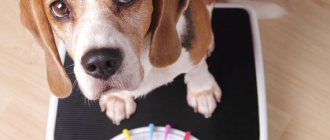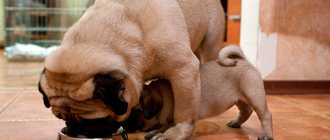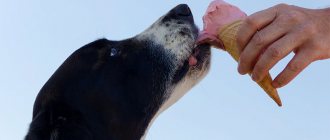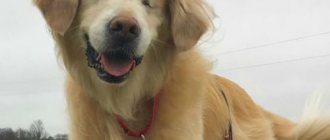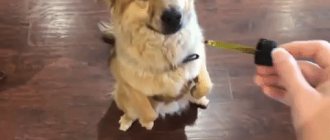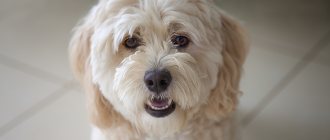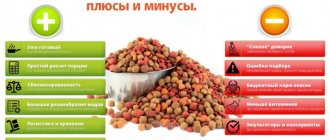Any diet for dogs requires long, hard work and endurance, primarily on the part of their owners! Since pets have become not just human assistants, but real family members, many of them have not escaped the problem of obesity.
According to statistics, today about 40% of animals suffer from this disease. Currently, for both humans and animals, obesity is considered a chronic disease.
It is impossible to look at an obese dog without sympathy: heaviness in gait, sagging belly, shortness of breath. And this is no longer a happy little tail who can happily run around on the grass and enjoy life, chasing his favorite ball. This is an unfortunate “victim” of the owner’s excessive “love”, reminiscent of a kind of “bedside table with legs”.
Many pet owners sincerely do not understand the danger of this condition and look for an excuse, motivating it something like this: “He looks at me with such sad eyes, how can I not give him a piece of sausage?!”
Why is obesity dangerous in dogs?
Here are just some of the dangers:
- First of all, obesity is dangerous because it has a negative impact on all internal organs and leads to disruption of their normal functioning. The list of complications caused by obesity in dogs is extremely long: metabolic disorders, decreased immunity, gastrointestinal diseases, heart disease, liver and kidney problems, skin diseases, blindness. The list could take a very long time.
- In addition, excess weight puts severe stress on the spine, limbs and joints. Over time, they simply cannot stand it and deforming arthrosis develops. The dog simply can no longer move independently.
Treats interfere with weight loss
Sometimes, in addition to the main diet in the form of dry food, the dog receives regular treats and eats the leftovers of breakfast, lunch and dinner for the owners. Of course, in this case, even scrupulous adherence to feeding standards will not help you lose weight.
- Remove your pet from the kitchen during family meals and snacks (or better yet, teach puppies this from a very early age).
- Warn all family members not to give the dog anything other than food and drinking water.
- If treats are used as a reward in training, calculate their calorie content and reduce the base ration by that number of calories.
Causes of obesity in animals
There can be several reasons for obesity:
- Obesity can be caused by serious diseases: hormonal imbalance, diseases of the thyroid gland, and gastrointestinal tract.
- Constant stress can also affect weight gain. If obesity is a consequence of any disease, then diet alone will not help. Competent and comprehensive treatment and proper diet are necessary.
Before putting your dog on a diet and radically changing its usual diet, it is necessary to find out what caused the pet to begin to gain weight. To do this, you need to contact a veterinary clinic. The need and correctness of prescribing a particular diet should be determined by the doctor after a complete examination of the animal and receipt of test results.
- Another cause of obesity is parasites.
- As a rule, diseases are very rare causes of obesity in dogs. In most cases, the main causes of this disease are: common overeating, age and insufficient physical activity.
Say no to treats and food from the table
Measuring food with apothecary precision is useless if the dog is regularly treated to various “snacks” or is allowed to eat the leftovers of the owner’s meal. When there are several household members and everyone strives to treat the pet, treats alone can accumulate more calories than you need for the whole day.
Leaving only dry food and completely eliminating treats is a necessary measure, without which it will be difficult to cure a dog of obesity. Explain this to all family members, emphasizing that the success of losing weight directly determines the life expectancy of their pet.
You should not think that a dog gets bored of eating the same thing every day: it does not at all need variety in the human sense. For her, the main thing is that food supplies all the amino acids, fatty acids, vitamins, minerals and other nutrients the body needs. This is fully provided by special foods designed to feed obese dogs.
IMPORTANT! If you cannot do without treats (for example, this is a reward for following commands), choose meat-based options: they satiate well and do not provoke overeating. However, the share of treats should not exceed 10%, and the share of the main diet should be proportionally reduced.
Types of diets
There are several types of diets for tailed pets. Let's look at them.
Hypoallergenic diet
The purpose of such a diet is to identify and then exclude from the dog’s diet foods that cause allergies in the pet. Such a diet begins with real experiments: the dog ate a pumpkin, began to itch - we don’t give him any more pumpkin. And so by the selection method. As a result, throughout his canine life the four-legged dog will eat only those foods to which he is not allergic.
Diet for obesity or castration in dogs
If the four-legged animal is not sick, but has grown fat from the “kindness of soul” of its owner, this illness should be urgently taken under control. As a rule, a diet for obesity or castration in dogs is a simple change and analysis of the diet, a banal reduction in portions by 10-15% and a gradual increase in physical activity.
In most cases, this works great, since the problem of obesity associated with overfeeding is a direct consequence of a slow metabolism (due to the fact that the body simply cannot cope with such a food load quickly) and an excess of calories entering the animal's body.
Diet for kidney disease in dogs
In general, in case of kidney disease, the basic principle of human nutrition is limited consumption of protein and fat. Guided by this principle, for many years veterinarians also prescribed a low-protein diet for kidney disease in dogs. However, as a result of numerous studies, in recent years this myth has been finally dispelled.
To date, there is no definitive evidence that feeding dogs with kidney disease a protein-rich diet actually harms the dog's health.
A dog is by nature a predatory animal. And “limiting protein in a dog’s diet can do more harm to the animal than good due to the risk of protein starvation” (G. Reinhart from the proceedings of the Dietetics Symposium).
Here are some links to a number of articles and studies on the role of protein in the diet of dogs with kidney failure. If you are the owner of a pet suffering from kidney disease, I advise you to read these publications:
- "Dogs with kidney disease" Dr. Lucy Pinkston, DVM.
- “Is a high protein diet bad for dog kidneys?” from the Veterinary Services Department, Drs. Foster & Smith, Inc.
- “Myths About Protein Restriction for Dogs with Reduced Kidney Function” by Kenneth Bovey, DVM, MS.
- “Enriched Nutrition for Aging Dogs” by Susan Thorpe-Vargas, PhD, and John S. Cargill, BS, MS.
- "Dispelling Myths About Squirrels" From Today's Breeder.
If your tail suffers from kidney disease, there is no doubt that a certain diet is definitely needed. But after a correct diagnosis, such a diet can only be developed by a competent veterinary specialist with modern knowledge and research, and not acting “the old fashioned way.” After all, science does not stand still, and in connection with new research opportunities, new competent approaches to what previously seemed to be unshakable postulates appear.
Dietary food for dogs with digestive system diseases.
Therapeutic food for dogs with sensitive digestion differs from the usual dietary food used for regular feeding of relatively healthy dogs. They are used for feeding for hepatitis, pancreatitis, and inflammatory bowel diseases. When digestion is clearly impaired due to illness. Such foods can also be used for acute gastritis, nonspecific gastroenteritis, food poisoning, simple dyspepsia, and hypersensitivity of the digestive tract. But not on an ongoing basis, but in courses for the period of treatment. And as prescribed by a veterinarian. These medicated dog foods are labeled Gastro or Gastrointestinal. They contain less fat and protein, which is beneficial for digestion of food. Their composition is aimed at preventing constipation or diarrhea, improving intestinal function. They also have an antiulcer effect. Any such dietary dog food is enriched with prebiotics, vitamins and minerals. Examples of Gastro foods are Royal Canin Gastro Intestinal, Farmina Vet Life Gastrointestinal, Happy Dog Intestinal.
Therapeutic foods for dogs with liver disease are labeled Hepatic. They include plant proteins with a high degree of digestibility. They have reduced copper content, but increased levels of antioxidants and zinc. The Hepatic class includes such foods as Royal Canin Hepatic HF16, Purina Pro Plan Veterinary Diets HP Hepatic. With the development of chronic liver failure, such foods are prescribed for life.
How to put a dog on a diet
So, how do you diet your dog? First of all, you should start with yourself. The owner must strictly follow all the rules, without following the dog’s lead due to forgetfulness or pity:
- First of all, make a list of acceptable products. Until your memory is finally ingrained in what you can feed your dog and what you can’t, this list should be in front of your eyes at all times.
- Buy food in advance, with a reserve, so as not to break the diet, consoling yourself with the phrase: Well, since healthy products are over, I’ll give him what I have, nothing will happen just once... If the dog is in the best shape, then there’s nothing to worry about if you replace one product with another. But this is not recommended for obese dogs.
- You cannot break the routine by skipping feedings.
- Don’t give in to pity when you see your pet’s pleading eyes.
- Have a conversation with your household about why your dog needs a diet. Explain that under no circumstances should you give your ponytail sweets, sausage or other foods harmful to the dog from the owner’s table “while no one is looking.”
- Changing your diet is stressful for the body. A sharp transition to new products leads to gastritis, constipation and other problems with the gastrointestinal tract. If this is a hypoallergenic diet, then foods to which the pet’s body reacts must be removed immediately. But if this is a regular diet for dogs, then new foods should be introduced gradually, reducing the amount of favorite foods.
- At first, it is recommended to leave the amount of food the same, replacing familiar foods with less calories.
- You should switch your pet from 2 meals a day to 3 meals a day, gradually reducing the dog’s usual daily amount of food consumed by 10%.
- If you do not “starve the dog”, but gradually replace foods and reduce portions, then, as a rule, the result will not be immediate. It takes time for the body to readjust and learn to function correctly. Therefore, if you do not immediately see the result, in no case should you abruptly abandon the diet, justifying your failure by its ineffectiveness.
CHAPTER 1. SPORTS FOR THE LAZY.
In fact, you don't have to change your usual lifestyle at all. All you need is a little time and desire to work with your dog. Take a closer look at what your four-legged friend loves most?
1. The dog loves to fetch balls. What a score! The only thing we need is to find a fairly hilly area and stand on top of a hill or small hill, naturally in a safe place, away from cars and roads. Start throwing the ball down cheerfully and with enthusiasm, and as soon as the dog grabs it, squat down, pat yourself on the knee and cheerfully call the dog by name or shouting “bring the ball!” As soon as the ball is delivered to you, praise the dog and offer to exchange the ball for a piece of the most delicious treat.
The dog must be fairly hungry before the walk. Give yourself a moment to catch your breath and throw the ball again. There is no need to throw often; after a few throws, switch the dog to something more pleasant for him. Smoothly progress this exercise up to ten times in several passes. To awaken your dog's interest in fetching, teach him to play at home with interactive balls and dumbbells, where you can hide a piece of meat. Don't be discouraged if things don't go smoothly right away. Sometimes you can whip up the dog’s interest by running to the ball for a race. Pretend that you are taking out a tasty treat from the ball itself.
2. The dog loves to dig holes. Just great! The only thing you need to make clear is where it is appropriate to dig and where it is better to refrain from doing so. So a field, a forest, sand is a great place, but mom’s favorite pink cous should be taboo!
